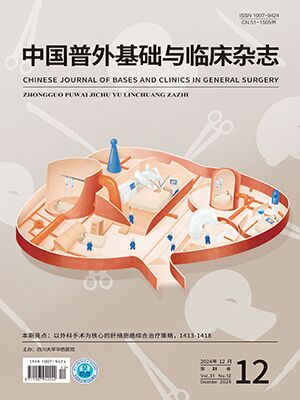| 1. |
Solis-Pazmino P, Salazar-Vega J, Lincango-Naranjo E, et al. Thyroid cancer overdiagnosis and overtreatment: a cross- sectional study at a thyroid cancer referral center in Ecuador. BMC Cancer, 2021, 21(1): 42. doi: 10.1186/s12885-020-07735-y.
|
| 2. |
杨映弘, 蔺原, 吴艳军, 等. 经乳房途径腔镜甲状腺切除术27例报告. 中国普外基础与临床杂志, 2005, 12(3): 299-300.
|
| 3. |
杨映弘, 吴艳军, 蔺原, 等. 腔镜与传统开放甲状腺切除术的比较. 中国微创外科杂志, 2006, 6(2): 119-120.
|
| 4. |
卢曼, 孙金中, 孙圣荣. 腔镜甲状腺手术发展与选择. 中国普外基础与临床杂志, 2022, 29(6): 816-822.
|
| 5. |
Pavlidis ET, Psarras KK, Symeonidis NG, et al. Robot-assisted thyroidectomy versus open thyroidectomy in the treatment of well differentiated thyroid carcinoma. JSLS. 2021, 25(3): e2021.00032. doi: 10.4293/JSLS.2021.00032.
|
| 6. |
曾令娟, 马静, 范林军, 等. 达芬奇机器人甲状腺癌根治术后引流管拔除时机的临床对照研究. 中国普外基础与临床杂志, 2020, 27(4): 460-463.
|
| 7. |
贺青卿, 朱见, 范子义, 等. 达芬奇机器人腋乳径路与传统开放手术治疗甲状腺微小癌的对照研究. 中华外科杂志, 2016, 54(1): 51-55.
|
| 8. |
王猛, 郑鲁明, 周鹏, 等. 腔镜与机器人甲状腺手术治疗甲状腺微小乳头状癌的对比研究. 肿瘤预防与治疗, 2021, 34(12): 1117-1122.
|
| 9. |
任婷婷, 兰德, 魏雪梅. 甲状腺切除患者手术前后嗓音功能评估. 中国耳鼻咽喉颅底外科杂志, 2020, 26(4): 369-372.
|
| 10. |
中国医师协会外科医师分会甲状腺外科医师委员会, 中国研究型医院学会甲状腺疾病专业委员会, 海峡两岸医药卫生交流协会海西甲状腺微创美容外科专家委员会, 等. 经胸前入路腔镜甲状腺手术专家共识(2017版). 中国实用外科杂志, 2017, 37(12): 1369-1373.
|
| 11. |
中国医师协会外科医师分会甲状腺外科医师委员会, 中国研究型医院学会甲状腺疾病专业委员会. 机器人手术系统辅助甲状腺和甲状旁腺手术专家共识. 中国实用外科杂志, 2016, 36(11): 1165-1170.
|
| 12. |
徐文, 李红艳, 胡蓉, 等. 嗓音障碍指数量表中文版信度和效度评价. 中华耳鼻咽喉头颈外科杂志, 2008, 43(9): 670-675.
|
| 13. |
Behlau M, Madazio G, Moreti F, et al. Efficiency and cutoff values of self-assessment instruments on the impact of a voice problem. J Voice, 2016, 30(4): 506.
|
| 14. |
中华人民共和国国家卫生健康委员会医政医管局. 甲状腺癌诊疗指南(2022年版). 中国实用外科杂志, 2022, 42(12): 1343-1357, 1363.
|
| 15. |
Van Lierde K, D’haeseleer E, Wuyts FL, et al. Impact of thyroidectomy without laryngeal nerve injury on vocal quality characteristics: an objective multiparameter approach. Laryngoscope, 2010, 120(2): 338-345.
|
| 16. |
Tae K, Ji YB, Song CM, et al. Safety and efficacy of transoral robotic and endoscopic thyroidectomy: the first 100 cases. Head Neck, 2020, 42(2): 321-329.
|
| 17. |
刘思维, 邵骏. 嗓音声学分析方法的研究现状. 临床耳鼻咽喉头颈外科杂志, 2022, 36(12): 966-970, 976.
|
| 18. |
Choi JY, Bae IE, Kim HS, et al. Comparative study of bilateral axillo-breast approach endoscopic and robotic thyroidectomy: propensity score matching analysis of large multi-institutional data. Ann Surg Treat Res, 2020, 98(6): 307-314.
|
| 19. |
Chung EJ, Park MW, Cho JG, et al. A prospective 1-year comparative study of endoscopic thyroidectomy via a retroauricular approach versus conventional open thyroidectomy at a single institution. Ann Surg Oncol, 2015, 22(9): 3014-3021.
|
| 20. |
Lee DY, Lee KJ, Han WG, et al. Comparison of transaxillary approach, retroauricular approach, and conventional open hemithyroidectomy: a prospective study at single institution. Surgery, 2016, 159(2): 524-531.
|
| 21. |
Van Damme S, Cosyns M, Deman S, et al. The effectiveness of pitch-raising surgery in male-to-female transsexuals: a systematic review. J Voice, 2017, 31(2): 244.
|




